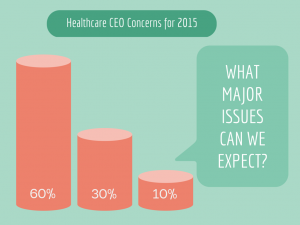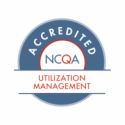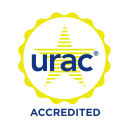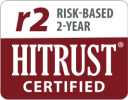Concerns for Hospital CEOs to Address
As 2015 approaches, many C-suite executives are bracing themselves for financial changes in the coming year. And as healthcare continues to rapidly evolve, addressing these five major concerns will help healthcare systems large and small anticipate any curveballs that come their way.
1. Decreased patient volume
It seems strange to think that in a system that just gained millions of new patients, the volume of care being provided would be on a downhill slope. However, as the quality of care continues to increase, the volume of individuals needing care is decreasing. Utilization and readmissions are down, thanks to preventative care and value based payment methods. In 2015, hospital CEOs need to plan for this decreased patient volume and find other areas to focus the revenue cycle on.
2. Health plans with high deductibles
Collections will be a challenge for health systems as more and more patients take on high deductible plans with greater cost-sharing. Communicating payment responsibility early on in the continuum of care and keeping on top of payments will help manage this concern, but it will still be a pressing issue. Some healthcare providers are instituting pre-service centers that educate patients about what to expect and their financial responsibilities.
3. Credit Ratings
With more and more hospital mergers, some of these organizational changes are creating negative credit ratings. Others are preparing for value-based purchasing, with also creates a flux in credit ratings. And for some, the downgrades are not just a single level–they’re multiple.
4. Payer Mix
Medicaid expansion raises many questions about payment methods in 2015. Cuts to the Disproportionate Hospital Share means uncertainty for healthcare systems and hospitals who have a large patient base with Medicaid cards. However, as more uninsured are transferred over to Medicaid, it also means many hospitals will finally have a way to be reimbursed for care provided. Focusing on denial reduction will also help boost their bottom line.
5. Continued EHR
Electronic health records continue to be costly and time consuming, but many providers are still struggling to use those tools to analyze the data they provide. Instead, they’re forever just trying to keep up. Tapping into that powerful resource and making efficiency improvements should be a major priority for hosptial CEOs in the coming year.
Bottom line
Revenue cycle improvement has to be on the radar of every hospital CEO–now more than ever. Whether it’s through assistance from an outside consulting firm, or via an internal group effort, without a spotlight on this area, many hospitals will suffer.
We want to hear from you: What concerns would you add to this list?






